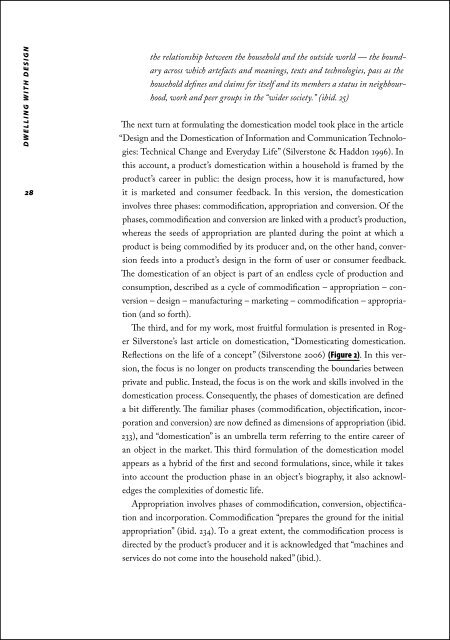Lataa ilmaiseksi
Lataa ilmaiseksi
Lataa ilmaiseksi
You also want an ePaper? Increase the reach of your titles
YUMPU automatically turns print PDFs into web optimized ePapers that Google loves.
D W E L L I N G W I T H D E S I G N<br />
28<br />
the relationship between the household and the outside world — the boundary<br />
across which artefacts and meanings, texts and technologies, pass as the<br />
household defines and claims for itself and its members a status in neighbourhood,<br />
work and peer groups in the “wider society.” (ibid. 25)<br />
The next turn at formulating the domestication model took place in the article<br />
“Design and the Domestication of Information and Communication Technologies:<br />
Technical Change and Everyday Life” (Silverstone & Haddon 1996). In<br />
this account, a product’s domestication within a household is framed by the<br />
product’s career in public: the design process, how it is manufactured, how<br />
it is marketed and consumer feedback. In this version, the domestication<br />
involves three phases: commodification, appropriation and conversion. Of the<br />
phases, commodification and conversion are linked with a product’s production,<br />
whereas the seeds of appropriation are planted during the point at which a<br />
product is being commodified by its producer and, on the other hand, conversion<br />
feeds into a product’s design in the form of user or consumer feedback.<br />
The domestication of an object is part of an endless cycle of production and<br />
consumption, described as a cycle of commodification – appropriation – conversion<br />
– design – manufacturing – marketing – commodification – appropriation<br />
(and so forth).<br />
The third, and for my work, most fruitful formulation is presented in Roger<br />
Silverstone’s last article on domestication, “Domesticating domestication.<br />
Reflections on the life of a concept” (Silverstone 2006) (Figure 2). In this version,<br />
the focus is no longer on products transcending the boundaries between<br />
private and public. Instead, the focus is on the work and skills involved in the<br />
domestication process. Consequently, the phases of domestication are defined<br />
a bit differently. The familiar phases (commodification, objectification, incorporation<br />
and conversion) are now defined as dimensions of appropriation (ibid.<br />
233), and “domestication” is an umbrella term referring to the entire career of<br />
an object in the market. This third formulation of the domestication model<br />
appears as a hybrid of the first and second formulations, since, while it takes<br />
into account the production phase in an object’s biography, it also acknowledges<br />
the complexities of domestic life.<br />
Appropriation involves phases of commodification, conversion, objectification<br />
and incorporation. Commodification “prepares the ground for the initial<br />
appropriation” (ibid. 234). To a great extent, the commodification process is<br />
directed by the product’s producer and it is acknowledged that “machines and<br />
services do not come into the household naked” (ibid.).
















